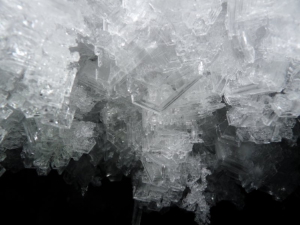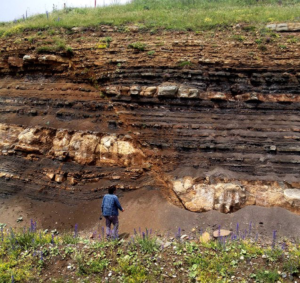
From Monday to Thursday during the week of #shareEGU20, the Early Career Scientists in our various Divisions are going to host a series of evening networking events. Find out more by clicking on the ‘Networking’ session search in the EGU Programme. If you are wondering if these events are for you, check out the Division description by the hosts included below. Every day this week we will be featuring the Divisions who are hosting events, and also adding a description of the other Divisions – in case you come across them in the week and wonder what they are all about.
Wednesday 6 May 2020, 20.00 CEST: Networking with the ECS of the AS division – REGISTER NOW!

Photo by Michiel Baatsen (from imaggeo).
The Atmospheric Sciences (AS) Division is one of the largest divisions of the European Geosciences Union. The research areas covered by the division extend from the large-scale dynamical/meteorological processes and systems in the atmosphere (like cyclones and global atmosphere circulation) to the small scale turbulent mixing, they cover the time frame from centuries (in connection with climate research) to seconds (in the context of fast chemistry). Atmospheric sciences include studies of the atmosphere composition, aerosol and cloud physics, gas-particles interactions and chemical reaction kinetics studied in the labs.
Read more here: Meet the AS Division!
Wednesday 6 May 2020, 19.00 CEST: Networking with the ECS of the CR division – REGISTER NOW!

Photo by Alexandra Guy (from imaggeo)
Cryosphere, in its broadest sense, is the study of solid water: ice and snow! Research in our division covers not only the Polar Regions, where ice and snow prevail, but also tropical (e.g Kilimanjaro glaciers) and mid-latitude (e.g Himalaya and Alps) regions. The cryosphere division deals with ice below and above you. This includes the frozen ground, ice caves, ice sheets, snow, glaciers of all sizes, sea ice, ice shelves, ice clouds and precipitation. We cover all aspects of time, from previous glaciations and ice maxima, to present day mass balance, to future glacier retreat and ice loss. The data for cryosphere research are varied, including paleoclimate data (such as ice cores and ocean sediments), observations (e.g weather stations and snow pits), laboratory work (such as isotope and foraminifera analysis), remote observations (e.g satellites and radar) and modelling (like ice sheet and ocean modelling). Cryosphere research covers all sizes including; microscopic ice and dust particles, metre-thick sea ice, kilometre-long ice flow, country-sized ice bergs and continent-wide ice sheets. If your research involves any aspect of the frozen world, then we are the division for you.
Wednesday 6 May 2020, 20.00 CEST: Networking with the ECS of the HS and GI divisions – REGISTER NOW!

Photo by Katarzyna Walczak (from imaggeo)
The Hydrological Sciences (HS) Division is concerned with all aspects of the terrestrial hydrological cycle (including precipitation, surface water, soil water, groundwater) from the pore scale to the global scale, and its relationships and interactions with the atmospheric part of the hydrological cycle. The division also covers the interaction between hydrology and geomorphology (e.g., erosion, sedimentation, groundwater systems), the relationships between hydrology and soils, as well as the interaction between the hydrosphere and the biosphere (e.g., ecohydrology, wetlands). The ways in which hydrological processes are observed, quantitatively computed, and forecasted are also addressed by the division. Management and operation of water resources by societies in various parts of the world is also within the division’s realm.
Geosciences Instrumentation and Data Systems (GI)

Photo by Rolf Sander (from imaggeo)
The Division on Geosciences Instrumentation and Data Systems (GI) intends to be a forum for developments in instrumentation, technology, methods and data handling used in any field of the various geosciences. By promoting the discussion between specialists from widely diverse fields, advances in instrumentation made in one field might be utilised in other areas also and encourage co-operation, thereby saving separate development work and making new approaches possible, which otherwise might still have to wait for years or even decades.
In addition you might come across this Division during the week; meet the Seismology Division!
Seismology as a discipline contributes to a large variety of both basic and applied scientific fields, and addresses urgent questions in the context of both natural resources and natural hazards. The Seismology (SM) Division at EGU aims to strengthen its interdisciplinarity and impact by driving the development from static to dynamic geophysical models, by conducting research that spans from acquisition parameters to petrophysical properties, and by supporting the transition from geo-modelling to geo-technical application. Thereby, the SM Division will be increasingly able to make relevant forecasts and provide valuable information to tackle future challenges in securing natural resources and quantifying natural hazards.
Due to the ongoing coronavirus outbreak, EGU has made the decision to cancel this year’s physical General Assembly in Vienna and instead offer a partial alternative meeting online, called #shareEGU20. Over the next few weeks in the run up to #shareEGU20, which will be held from the 4 – 8 May 2020, we will be posting regular updates and information about how to get involved, what EGU can offer during this week and how to find each other. We know that there will be many, many questions that people have, and we are learning how to do this right along with you, so please send us your questions over social media or by emailing egu2020@copernicus.org or info@egu.eu. We’re looking forward to sharing EGU with you, online!





